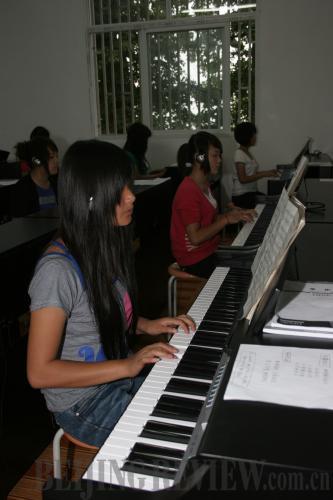|
 |
|
THE SAME AS IN CITIES: In the Secondary Vocational School of Laifeng County, Enshi Prefecture, students play digital pianos usually only seen in cities (PING NA) |
To make students practice what they have learned from textbooks, the school invested 4 million yuan ($590,840) in 2009, constructing a practical training building. Here there are computer rooms, multi-media classrooms, welding classrooms, piano rooms, a gym and an art studio.
"Our goal is to nurture practice-oriented technical talents," said Wang. More than 95 percent of the students can find jobs after graduating. Many are employed in coastal areas such as Guangdong. Moreover, since 1992, there have been more than 1,000 students from the school recruited to university by taking part in the country's College Entrance Examination, Wang said.
Tujia Ethnic Group
Population: about 8 million
Major area of distribution: Hubei and Hunan provinces
Language: Tujia
Traditionally, Tujia women wear jackets trimmed with lace and with short, broad sleeves. They wear long skirts, and wrap their coiled hair in cloth. They adorn themselves with necklaces, earrings, bracelets and ankle bracelets. Tujia men wear short jackets with many buttons in front.
In the feudal times, Tujia chiefs and officials had wooden homes with tiled roofs and carved columns, while ordinary people lived in thatched bamboo-woven houses. The Tujia people had some rather distinctive taboos. Young girls or pregnant women were not permitted to sit on thresholds, while men could not enter a house wearing straw raincoats or carrying hoes or empty buckets. Nor were people allowed to approach the communal fire or say ostensibly unlucky things on auspicious days. Young women were not allowed to sit next to male visitors, although young girls could. At worship ceremonies, cats were kept away as their meowing was considered unlucky.
Miao Ethnic Group
Population: about 8.9 million
Major area of distribution: Guizhou, Hunan, Yunnan, Sichuan, Hainan and Hubei provinces and Guangxi Zhuang Autonomous Region
Language: Miao
The Miao people form one of the largest ethnic minorities in southwest China. A wide distribution has resulted in marked differences in dialect, names and clothes. Some Miao people from different areas have great difficulty in communicating with each other. Their art and festivals also differ between areas.
The Miao have a highly diversified culture developed from a common root. They are fond of singing and dancing, and have rich folk literature. Their songs, which do not rhyme and vary greatly in length from a few lines to more than 15,000, are easy to understand and are very popular among the Miao people.
Because timber resources are plentiful in most Miao areas, houses are usually built of wood and roofed with fir bark or tiles or are thatched.
(Source: www.china.org.cn)
| 